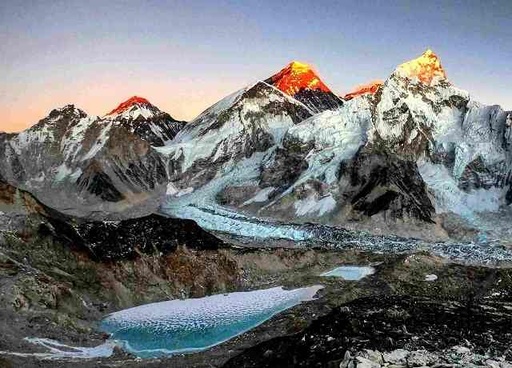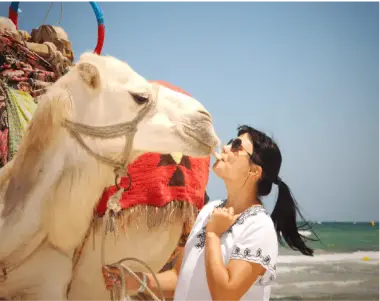| Everest base camp trek | Kilimanjaro climb |
Maximum elevation | 5,545 meters (18,192 feet) Kalapathther
5364 meters (17598 feet) Everest Base Camp. | 5,895 meters (19,341 feet) Summit |
Major Attractions | Mount Everest, Local Sherpa Villages( Lukla, Namche Bazaar, Tengboche, Dingboche) Gorak Shep, Base Camp of Over 8000m peaks such as Mount Everest, Makalu, Lhotse, Khumbu Glacier | The Marangu Gate, Mandara Hut, Horombo Hut, Kibo Hut, Gilman's Point, Uhuru Peak, The Mweka Route |
Permits | Pasang Lhamu Rural Municipality Permit, A TIMS (Trekkers' Information Management System) card and Sagarmatha National Park entry permit | Climbers are required to obtain a permit from the Kilimanjaro National Park Authority before attempting the climb. |
Total day / Itinerary | 10-14 days | 5-9 days |
Things to see on the trek | You will see beautiful landscapes, including lush forests, mountains streams, and terraced fields, as well as traditional villages and monasteries like Thyangboche (Oldest Monastery in Khumbu region), Sama gompa, Rachen gompa, sho gompa, Lho gompa | You will witness the change in landscape and vegetation through different ecological zones, such as rainforest, moorland, and alpine desert, as well as unique flora and fauna like giant heather, lobelia, and the Kilimanjaro Colobus monkey. |
The difficulty of the trek | The trek is considered moderately difficult. High altitude sickness, Extreme Weather, and Staying at night over 5000m are the major challenges of Everest Base Camp Trek | Climbing Mount Kilimanjaro is considered a challenging hike. Challenging terrains, high altitude sickness, and lack of amenities are the main challenges of Kilimanjaro climbing |
Total distance | 120 km from Lukla to Everest Base Camp | 40-80 km Depending on climbing Routes |
Side trekking routes | Gokyo Lakes Trek, Three Passes Trek, Renjo La Pass Trek, Island Peak Climb, Cho La Pass Trek. | The Lemosho Route, Machame Route, Rongai Route, Marangu Route, Umbwe Route, and Western Breach Route |
Risk of altitude sickness | Due to the high altitude of the Everest Base Camp Trek, trekkers may develop altitude sicknesses such as Headache, nausea, exhaustion, shortness of breath, appetite loss, dizziness, and facial, hand, and foot edema are just a few of its symptoms. | Mount Kilimanjaro climbers run the danger of getting altitude sickness. Acclimatizing appropriately is crucial, as is being aware of the signs of altitude sickness, which include headache, Shortness of breath, nausea, and exhaustion. |
Cost | $1300 to 1500 | $2000 to $4,000 |
Flight | Trekkers have to fly Kathmandu to Lukla to Kathmandu by small plane | No domestic flight is needed for Kilimanajro Climb. |
Trekking routes | The trekking route of the Everest Base Camp Trek starts and ends in Lukla, Nepal. The route passes through traditional Sherpa villages, and lush alpine forests, offering beautiful views landscape and Himalayas, including Mount Everest. The main stops on the trek routes include Lukla, Namche Bazaar, Tengboche, Dingboche, and Gorak Shep, the Base Camp of Mount Everest, and return through the same route. | There are few routes for Kilimanjaro Climb, Marangu Route is considered the most popular route for climbing Mount Kilimanjaro. It starts at the Marangu Gate and ends at the Mweka Gate. It's a 6-day trek in total, with 5 days of climbing and a summit day on the 6th day. |
The best time | Autumn (September to November) and Spring (March to May) are the main best season and winter (December to February) is also the doable season for Everest Base Camp Trek. | January to February and June to October are the best seasons for Kilimanjaro Climb. |
Weather | It is usually temperate and sunny during the trekking season, which runs from September to November and March to May. At higher elevations, though, it can get chilly and snowy at night. The daytime temperature is relatively mild and the sky is typically clear during the spring season (March-May), but the evenings can get quite chilly. On the route to the base camp, there is a rhododendron woodland that will be in full bloom at this time. The days are typically clear and sunny during the fall season (September to November), but the nights can get very chilly, especially at higher altitudes. The base camp can see temperatures as low as -4°F (-20°C). The trek is typically not advised between June and August because of the risk of landslides and intense rain. | During the dry seasons of January to February and June to October, the weather is generally more stable, with less chance of rain and clearer skies. However, it's important to note that the weather on the mountain can be unpredictable, and hikers should be prepared for all types of weather conditions. It's also important to note that, because of the altitude, the sun can be intense and it's essential to wear sunscreen and sunglasses. |
Facilities | Food on EBC Trek:
Available at most teahouses along the trek route, with varying availability and quality.
Accommodation:
Good facilities lodges attached bathrooms in lower altitudes and Basic lodges in higher altitudes that teahouses provide accommodation, with shared bathrooms and dormitory-style rooms. Private cozy rooms are available.
Electricity:
Available in all places typically only available in larger villages and through power generators at some teahouses.
Internet:
Most of the places works cell phone and Limited in bad weather typically in gorges and river sidesHot shower: Available all teahouses but not always reliable and can be quite expensive as you climb high. Laundry:
Available at some teahouses but quality and availability can vary.
Drinking water:
Available at most teahouses, either through taps or by purchasing bottles.
ATM and banks:
Available up to Namche Bazar (the second day of the trek) on the trek route, so it is important to bring enough cash for the duration of the trek.
. | Food on Kilimanjaro Climb:
Most organized treks include meals as part of the package. The food provided is typically basic, with a mix of local and Western cuisine.
Accommodation: Accommodation on the Marangu Route is in huts, which is different from other routes where accommodation is in tents. The huts have bunk beds with mattresses, but hikers should bring their own sleeping bags. There is no electricity in huts, and lighting is provided by candles or headlamps.
Electricity:
There is no electricity in the huts along the Marangu Route, and lighting is provided by candles or headlamps. It's best to bring a power bank or extra batteries for your electronic devices.
Internet:
There is no internet connection along the Marangu Route.
Hot shower:
There are no hot showers along the Marangu Route.
Drinking water:
Drinking water is typically provided by the tour operator, but it's best to bring a water bottle and water purification tablets.ATM and banks:
There are no ATMs or banks along the Marangu Route. |
Preparation required | Physical fitness and proper training Adequate gear and equipment Obtaining necessary permits and arranging for a guide and porters Acclimatization and planning for altitude sickness Researching and familiarizing with the itinerary, route, and local culture Packing appropriate clothing and supplies physical | Physical fitness Altitude training Equipment and clothing Travel Insurance Obtaining a visa
Proper Gears Get a medical check-up
|
Packing list | Hiking boots Warm and waterproof clothing and shoes Sleeping bag Headlamp or flashlight Water bottles and water purification tablets First-aid kit and personal medication Sunscreen and sunglasses Hat or beanie Warm gloves and thermal layers Down jacket Rain gear Personal hygiene items Camera and extra batteries Cash and credit card Travel documents and permits | Hiking boots Warm clothing Sleeping bag and Sleeping mat Headlamp or flashlight Water bottles and water purification tablets Sunscreen and sunglasses: First aid kit and personal medicine
Camera Snacks Warm hat and gloves Passport and travel documents
Personal hygiene items Cash or credit card
Rain Gears Maps and guidebooks |
|
|
|








